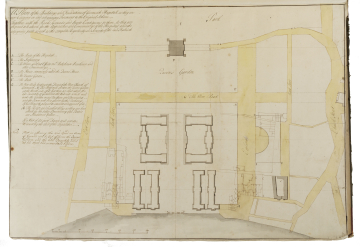
Browse
Reference number
Purpose
Aspect
Scale
Inscribed
Signed and dated
- Undated but datable c.1728, contemporary with 109/5
Medium and dimensions
Hand
Watermark
Notes
The inscription marked G on the left side of the drawing describes how moving the road northwards would result in a loss of an acre of ground from the Queen's Garden. This loss is to be compensated for by extending the garden in a more uniform plan to the west, an alteration shown on the drawing by the deletion of the historic 'Fryers Road' (Friars Road), the line of which is shown on [11/1]. As a result, the Crown will be a gain by this Exchange if his Majesty please to consent and approve of it.
The idea of aligning the Romney Road with the church was part of a broader ambition by Colen Campbell's office to regularise the whole site. One aim was the enclosure of the site with a boundary wall; see [12/1]. The wall has not yet been drawn on the present plan, and the axis on the central west portico of the King William block is still emphasised. This cross axis is marked with a dotted line across the plan and is reinforced in this scheme by the plan of the proposed Infirmary (marked B). This has a large semi-circular recess in its front facade that corresponds to the central range of the King William block. Within Greenwich itself, the plan shows a proposed new service building, marked C. This is the Mews and Out Offices, including a Bakehouse, Brewhouse and other Conveniences.
Literature
Level
Sir John Soane's collection includes some 30,000 architectural, design and topographical drawings which is a very important resource for scholars worldwide. His was the first architect’s collection to attempt to preserve the best in design for the architectural profession in the future, and it did so by assembling as exemplars surviving drawings by great Renaissance masters and by the leading architects in Britain in the 17th and 18th centuries and his near contemporaries such as Sir William Chambers, Robert Adam and George Dance the Younger. These drawings sit side by side with 9,000 drawings in Soane’s own hand or those of the pupils in his office, covering his early work as a student, his time in Italy and the drawings produced in the course of his architectural practice from 1780 until the 1830s.
Browse (via the vertical menu to the left) and search results for Drawings include a mixture of Concise catalogue records – drawn from an outline list of the collection – and fuller records where drawings have been catalogued in more detail (an ongoing process).

